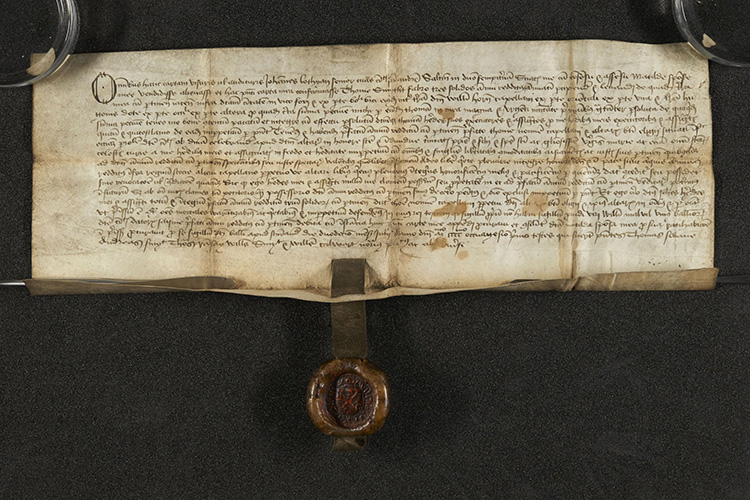Getting muddy with manuscripts
 Heather Curtis, a first-year PhD student at the University of St Andrews, has won the Scottish Records Association’s Tunnock Prize – an award for an essay utilising archival research to expand our knowledge of Scottish history. She explains how working with manuscripts in the Library’s Special Collections inspired her winning paper: ‘Transactiones pro animabus: rent charges and the economics of salvation in late mediaeval St Andrews’.
Heather Curtis, a first-year PhD student at the University of St Andrews, has won the Scottish Records Association’s Tunnock Prize – an award for an essay utilising archival research to expand our knowledge of Scottish history. She explains how working with manuscripts in the Library’s Special Collections inspired her winning paper: ‘Transactiones pro animabus: rent charges and the economics of salvation in late mediaeval St Andrews’.
As the semester draws to a close, like many, I’m heading home to face a festive glut of food, family and the lingering question that escapes every year from a freshly opened box of After Eights: “What does a mediaeval history student actually do?” The primary challenge is convincing my gran that it has nothing to do with Time Team. Little to no mud is involved – unless you fall over on your way to the library. This Christmas, however, my answer might be somewhat different.
Palaeography classes were a distinct highlight of the MLitt Mediaeval History course I completed at the University last year. They were enchanting and empowering in equal measure. Learning from the broad range of manuscripts accessible through Special Collections created an immediacy with history which I had never quite experienced in the short-loan section of the library. I do not mean only the visceral thrill of handling antique documents, imagining whose hands they may have passed through over the centuries. No, the greater enjoyment of working with original archival materials was the defining sensation of experiencing history as a professional academic discipline. Transcribing, translating and teasing out inspiration from the University’s collection of mediaeval municipal charters was an opportunity to join the conversation between past and present, even with the uncertain voice of a lowly postgraduate student. I may not have been muddy – most likely a prerequisite for entry into the Napier Reading Room – but working with these manuscripts offered an exciting potential for discovery.
Initially, the charter which comprised our final palaeography assignment (ms37752, pictured) appeared impenetrable. Its bedrock of dense abbreviations and flourishes provoked frustration and, finally, satisfaction as we learned to decipher the secrets of the cursive secretary hand. Dated 12 July 1481, the writ details the sale by John Lothian of the right to uplift rents from his land on Market Street to Thomas Smith. So far, so familiar. However, as well as paying an unspecified sum for the perpetual transfer of the rents, the contract compelled Thomas to secure prayers for the souls of John and his family from the chaplain of St Elegius’ altar in the parish church. The indivisibility of faith and finance in the Middle Ages is apparent, but what can we infer from this brand of commodified salvation about people’s attitudes towards the Church on the eve of the Reformation? Working during lockdown, digitised transcripts of pittance writs from the University’s collection were an invaluable resource as I began to dig deeper.
The proliferation of fifteenth-century charters exchanging the rights to collect rents for salvific prayers is testament to the populace’s appetite for converting earthly tenements into privileged positions in the afterlife. This process considerably enrichened the parish church, which saw more than twenty chaplainries established in the century following its relocation to South Street in 1412. However, agreements such as John Lothian’s charter demonstrate not only a commercial but also a depersonalised approach to securing salvation. As the priest’s prayers for his soul echoed at the altar, John would be there in name alone. My research suggests that this rupture and the growing financial burden of rents owed to the church increased the potential for resentment amongst parishioners. It is no coincidence, therefore, that John Knox delivered an evisceration of clerical greed when he took to the pulpit in St Andrews in June 1559, immediately and violently igniting the Reformation in Scotland’s ecclesiastical capital. I am very grateful to the Scottish Records Association for recognising my essay with the Tunnock Prize – an appropriate award for an individual whose deadlines inevitably coincide with diminishing cairns of tea cakes!
So, what will I tell my gran this Christmas when she enquires about the activities of a mediaeval history student? Simple: I may not have found any artefacts, but I’ve been busy excavating ideas.
Heather Curtis
PhD student
Previously student on ME5105 and ME5106,
Introduction to Palaeography with Manuscript and Codicological Studies, I and II
Taught by Dr Margaret Connolly and Rachel Hart
